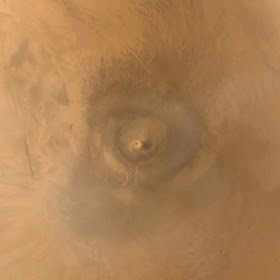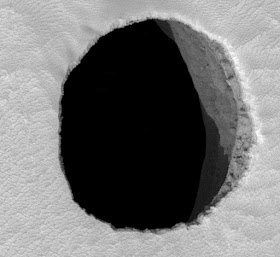NASA MARS GLOBAL SURVEYOR (1996-2007)
Arsia Mons (17, 761 m 17 / - 58, 721ft / 11 mi)
MARS
1. In Arsia Mons Spiral Cloud, June 19, 2001
2. In Possible caves of Arsia Mons, HiRISE image, Laszlo P. Keszthelyi, August 9, 2007
The mountain
Arsia Mons (20,000 m / 20 km - 63, 360ft / 12mi) is the southernmost of three volcanos with Ascraeus Mons, and Pavonis Mons (collectively known as Tharsis Montes) on the Tharsis bulge near the equator of the planet Mars, the tallest volcano in the solar system, Olympus Mons, is to its northwest. Arsia Mons was named by Giovanni Schiaparelli after the legendary Roman forest of Arsia Silva.
Arsia Mons is a shield volcano with a relatively low slope and a massive caldera at its summit. It is large enough to cover the state of New Mexico.
The caldera of Arsia Mons was formed when the mountain collapsed in on itself after its reservoir of magma was exhausted. There are many other geologic collapse features on the mountain's flanks.
The caldera floor formed around 150 millions years ago.
One of the benefits of the Mars Global Surveyor (MGS) Mars Orbiter Camera (MOC) Extended Mission is the opportunity to observe how the planet's weather changes during a second full martian year. The picture of Arsia Mons (photo 1 above) was taken June 19, 2001 southern spring equinox occurred the same day. On this particular day (the first day of Spring), the MOC wide angle cameras documented an unusual spiral-shaped cloud within the 110 km (68 mi) diameter caldera- the summit crater- of the giant volcano. Because the cloud is bright both in the red and blue images acquired by the wide angle cameras, it probably consisted mostly of fine dust grains. The cloud's spin may have been induced by winds off the inner slopes of the volcano's caldera walls resulting from the temperature differences between the walls and the caldera floor, or by a vortex as winds blew up and over the caldera. Similar spiral clouds were seen inside the caldera for several days; we don't know if this was a single cloud that persisted throughout that time or one that regenerated each afternoon. Sunlight illuminates this scene from the left/upper left.
The caldera floor formed around 150 millions years ago.
One of the benefits of the Mars Global Surveyor (MGS) Mars Orbiter Camera (MOC) Extended Mission is the opportunity to observe how the planet's weather changes during a second full martian year. The picture of Arsia Mons (photo 1 above) was taken June 19, 2001 southern spring equinox occurred the same day. On this particular day (the first day of Spring), the MOC wide angle cameras documented an unusual spiral-shaped cloud within the 110 km (68 mi) diameter caldera- the summit crater- of the giant volcano. Because the cloud is bright both in the red and blue images acquired by the wide angle cameras, it probably consisted mostly of fine dust grains. The cloud's spin may have been induced by winds off the inner slopes of the volcano's caldera walls resulting from the temperature differences between the walls and the caldera floor, or by a vortex as winds blew up and over the caldera. Similar spiral clouds were seen inside the caldera for several days; we don't know if this was a single cloud that persisted throughout that time or one that regenerated each afternoon. Sunlight illuminates this scene from the left/upper left.
Dark pits on some of the Martian volcanoes have been speculated to be entrances into caves . A HiRISE image (cf. photo 2 above), looking essentially straight down, saw only darkness in this pit. This time the pit was imaged from the west. Since the picture was taken at about 2:30 p.m. local (Mars) time, August 9, 2007, the sun was also shining from the west. We can see the eastern wall of the pit catching the sunlight. This confirms that this pit is essentially a vertical shaft cut through the lava flows on the flank of the volcano. Such pits form on similar volcanoes in Hawaii and are called "pit craters." They generally do not connect to long open caverns but are the result of deep underground collapse. From the shadow of the rim cast onto the wall of the pit NASA could calculate that the pit is at least 178 meters - 584 feet deep. The pit is 150 x 157 meters (492 x 515 feet) across.
The mission
Mars Global Surveyor (MGS) was an American robotic spacecraft developed by NASA's Jet Propulsion Laboratory and launched November 7, 1996. Mars Global Surveyor was a global mapping mission that examined the entire planet, from the ionosphere down through the atmosphere to the surface. As part of the larger Mars Exploration Program, Mars Global Surveyor performed monitoring relay for sister orbiters during aerobraking, and it helped Mars rovers and lander missions by identifying potential landing sites and relaying surface telemetry.
It completed its primary mission in January 2001 and was in its third extended mission phase when, on 2 November 2006, the spacecraft failed to respond to messages and commands. A faint signal was detected three days later which indicated that it had gone into safe mode. Attempts to recontact the spacecraft and resolve the problem failed, and NASA officially ended the mission in January 2007.
The Mars Orbiter Camera (MOC) science investigation used 3 instruments: a narrow angle camera that took (black-and-white) high resolution images (usually 1.5 to 12 m per pixel) and red and blue wide angle pictures for context (240 m per pixel) and daily global imaging (7.5 km per pixel). MOC returned more than 240,000 images spanning portions of 4.8 Martian years, from September 1997 and November 2006.[6] A high resolution image from MOC covers a distance of either 1.5 or 3.1 km long. Often, a picture will be smaller than this because it has been cut to just show a certain feature. These high resolution images may cover features 3 to 10 km long. When a high resolution image is taken, a context image is taken as well. The context image shows the image footprint of the high resolution picture. Context images are typically 115.2 km square with 240 m/pixel resolution.
___________________________________________
2019 - Wandering Vertexes...
by Francis Rousseau

